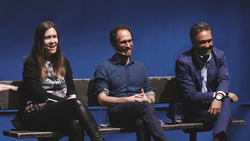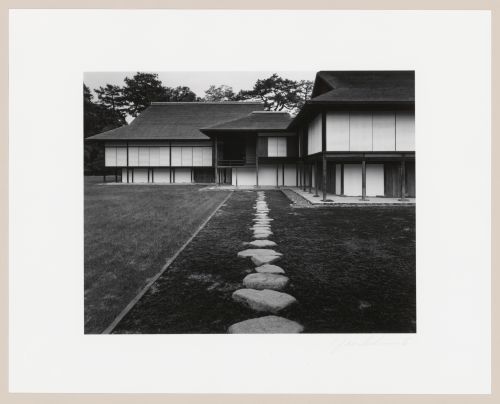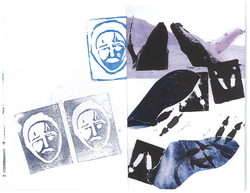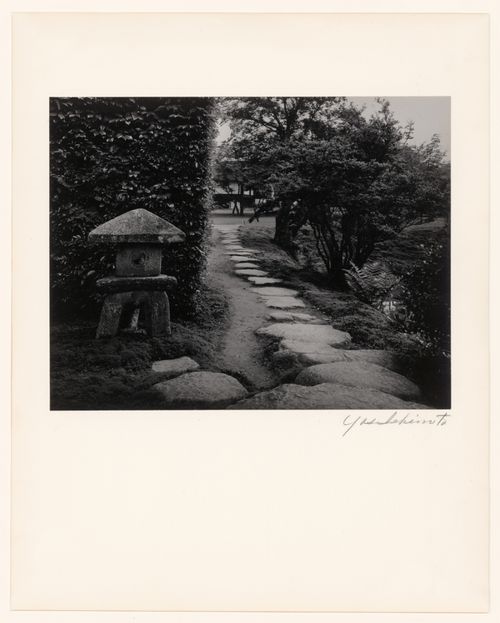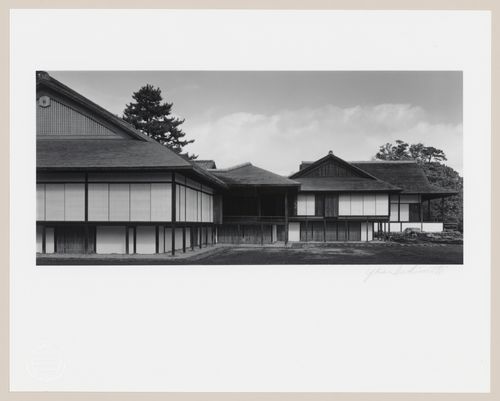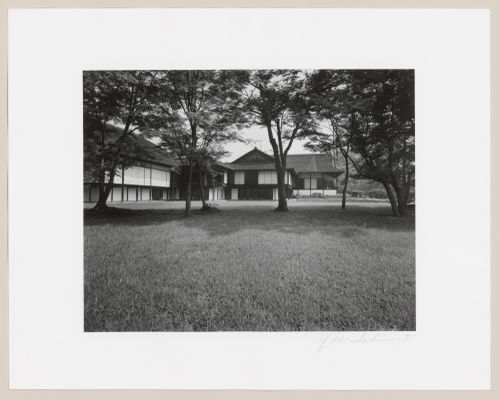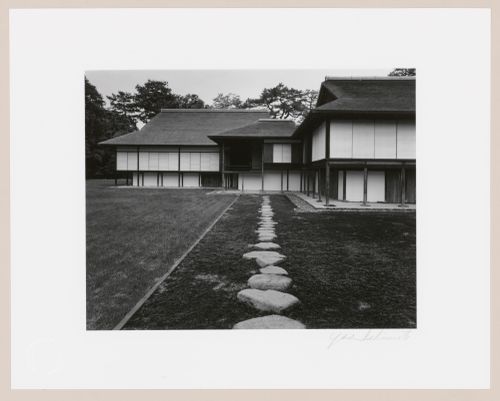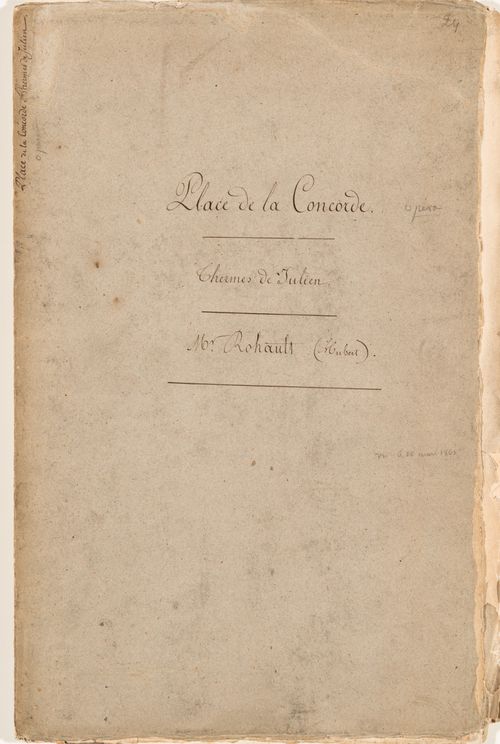No Parks?
Are parks bad? These quarantined bits of land and water speak to a confused desire for some kind of “nature”—and they might be good for our health—but do they also serve to excuse our continued bad behaviour? Parks are not innocent. City parks are real estate assets and urban “amenities” created by planners, landscape architects, hydrological engineers, police(...)
25 May 2017
No Parks?
Actions:
Description:
Are parks bad? These quarantined bits of land and water speak to a confused desire for some kind of “nature”—and they might be good for our health—but do they also serve to excuse our continued bad behaviour? Parks are not innocent. City parks are real estate assets and urban “amenities” created by planners, landscape architects, hydrological engineers, police(...)
PH1986:0286
Description:
- After first photographing Katsura Rikyu (also known as Katsura Imperial Villa) in 1953, Yasuhiro Ishimoto returned there in 1982 and took another series of photographs, this time with many in colour, often using the same or very similar views to those of his 1953 photographs (Ishimoto, pp. 265-266). - This photograph shows the south lawn (also known as the court football [kemari] field) in the foreground, at left, and the moss garden in the foreground, at right (Isozaki, et al, pp. 52-53, repr.; pp. 68-69, repr.; pp. 78, repr.; p. 244; Ito, site plan; Tange, n.p., plan).
architecture, landscape architecture
1982
View of the New Palace (also known as the New Goten), the Music Room and the Middle Shoin showing stepping-stones in the foreground, Katsura Rikyu (also known as Katsura Imperial Villa), Kyoto, Japan
Actions:
PH1986:0286
Description:
- After first photographing Katsura Rikyu (also known as Katsura Imperial Villa) in 1953, Yasuhiro Ishimoto returned there in 1982 and took another series of photographs, this time with many in colour, often using the same or very similar views to those of his 1953 photographs (Ishimoto, pp. 265-266). - This photograph shows the south lawn (also known as the court football [kemari] field) in the foreground, at left, and the moss garden in the foreground, at right (Isozaki, et al, pp. 52-53, repr.; pp. 68-69, repr.; pp. 78, repr.; p. 244; Ito, site plan; Tange, n.p., plan).
architecture, landscape architecture
Project
AP075.S1.1999.PR02
Description:
Project series documents Cornelia Hahn Oberlander's landscape project for the proposed Commonwealth Square of the Art Gallery of Hamilton, on Main Street West in Hamilton, Ontario. Oberlander worked on this project in 1999-2002 while the architectural firm Kuwabara, Payne, McKenna, Blumberg Architects was in charge of the building's renovations. The building was completed in 2005, but Oberlander's proposal for the landscaping redesign of Commonwealth Square was not realized. Oberlander's first proposal consisted in adding an oval-shaped mounded lawn in the centre of a paved plaza situated between the art gallery and Main Street West. A second proposal also documented in this project series included two curved access ramps leading to a terrace next to the building with trees planting at the far edge of the plaza and along the street and the underground parking entrance. The project series contains design development drawings for Oberlander's landscaping, such as sketches, sections, landscape plans and renderings. The project series also includes renderings and working drawings for the building by KPMB architectural firm, and building plans for the existing building used as reference. The project is also documented through correspondence, including with clients, architects and consultants, Oberlander's concept notes, documents related to the plant selection, financial documents, documentation on the art gallery, and press clippings and articles on the project. It also comprises photographs of the existing landscaping on Main Street West plaza, including the Irving Zucker Sculpture Court.
1974-2002
Commonwealth Square, Art Gallery of Hamilton, Ontario (1999)
Actions:
AP075.S1.1999.PR02
Description:
Project series documents Cornelia Hahn Oberlander's landscape project for the proposed Commonwealth Square of the Art Gallery of Hamilton, on Main Street West in Hamilton, Ontario. Oberlander worked on this project in 1999-2002 while the architectural firm Kuwabara, Payne, McKenna, Blumberg Architects was in charge of the building's renovations. The building was completed in 2005, but Oberlander's proposal for the landscaping redesign of Commonwealth Square was not realized. Oberlander's first proposal consisted in adding an oval-shaped mounded lawn in the centre of a paved plaza situated between the art gallery and Main Street West. A second proposal also documented in this project series included two curved access ramps leading to a terrace next to the building with trees planting at the far edge of the plaza and along the street and the underground parking entrance. The project series contains design development drawings for Oberlander's landscaping, such as sketches, sections, landscape plans and renderings. The project series also includes renderings and working drawings for the building by KPMB architectural firm, and building plans for the existing building used as reference. The project is also documented through correspondence, including with clients, architects and consultants, Oberlander's concept notes, documents related to the plant selection, financial documents, documentation on the art gallery, and press clippings and articles on the project. It also comprises photographs of the existing landscaping on Main Street West plaza, including the Irving Zucker Sculpture Court.
Project
1974-2002
4 June 2023, 1pm to 4pm
PH1986:0268
Description:
- Photographs PH1986:0148 - PH1986:0283 form a sequence of views. Accession numbers follow an order established by the photographer that is based on the temporal experience of walking through the grounds of Katsura Rikyu (also known as Katsura Imperial Villa) (see acquisition file). - Yasuhiro Ishimoto returned to Katsura Rikyu (also known as Katsura Imperial Villa) in 1982 and took another series of photographs, this time with many in colour, often using the same or very similar views to those of his 1953 photographs at the same location (Ishimoto, p. 266). - The south lawn (also known as the court football [kemari] field) and the Middle Shoin are visible in the background, (Isozaki, et al, p. 244; Ito, site plan).
architecture, landscape architecture
1953
View of the Triangular Lantern (also known as the Snow-viewing Lantern) and stepping-stones near the Shoiken, Katsura Rikyu (also known as Katsura Imperial Villa), Kyoto, Japan
Actions:
PH1986:0268
Description:
- Photographs PH1986:0148 - PH1986:0283 form a sequence of views. Accession numbers follow an order established by the photographer that is based on the temporal experience of walking through the grounds of Katsura Rikyu (also known as Katsura Imperial Villa) (see acquisition file). - Yasuhiro Ishimoto returned to Katsura Rikyu (also known as Katsura Imperial Villa) in 1982 and took another series of photographs, this time with many in colour, often using the same or very similar views to those of his 1953 photographs at the same location (Ishimoto, p. 266). - The south lawn (also known as the court football [kemari] field) and the Middle Shoin are visible in the background, (Isozaki, et al, p. 244; Ito, site plan).
architecture, landscape architecture
PH1986:0195
Description:
- Photographs PH1986:0148 - PH1986:0283 form a sequence of views. Accession numbers follow an order established by the photographer that is based on the temporal experience of walking through the grounds of Katsura Rikyu (also known as Katsura Imperial Villa) (see acquisition file). - After first photographing Katsura Rikyu (also known as Katsura Imperial Villa) in 1953, Yasuhiro Ishimoto returned there in 1982 and took another series of photographs, this time with many in colour, often using the same or very similar views to those of his 1953 photographs (Ishimoto, pp. 265-266). - The south lawn (also known as the court football [kemari] field) is visible in the foreground (Isozaki, et al, pp. 68-69, repr.; p. 244; Ito, site plan).
architecture, landscape architecture
1982
View of the Shoin complex showing the Old Shoin, the Middle Shoin and the New Palace (also known as the New Goten), Katsura Rikyu (also known as Katsura Imperial Villa), Kyoto, Japan
Actions:
PH1986:0195
Description:
- Photographs PH1986:0148 - PH1986:0283 form a sequence of views. Accession numbers follow an order established by the photographer that is based on the temporal experience of walking through the grounds of Katsura Rikyu (also known as Katsura Imperial Villa) (see acquisition file). - After first photographing Katsura Rikyu (also known as Katsura Imperial Villa) in 1953, Yasuhiro Ishimoto returned there in 1982 and took another series of photographs, this time with many in colour, often using the same or very similar views to those of his 1953 photographs (Ishimoto, pp. 265-266). - The south lawn (also known as the court football [kemari] field) is visible in the foreground (Isozaki, et al, pp. 68-69, repr.; p. 244; Ito, site plan).
architecture, landscape architecture
PH1986:0174
Description:
- Photographs PH1986:0148 - PH1986:0283 form a sequence of views. Accession numbers follow an order established by the photographer that is based on the temporal experience of walking through the grounds of Katsura Rikyu (also known as Katsura Imperial Villa) (see acquisition file). - Yasuhiro Ishimoto returned to Katsura Rikyu (also known as Katsura Imperial Villa) in 1982 and took another series of photographs, this time with many in colour, often using the same or very similar views to those of his 1953 photographs at the same location (Ishimoto, p. 266). - This photograph was taken from the south lawn (also known as the court football [kemari] field), showing the New Palace (also known as the New Goten), the Music Room, the Middle Shoin and the Old Shoin, from left to right (Tange, p. 12; Isozaki, et al, pp. 68-69, repr.).
architecture, landscape architecture
1953
View of the New Palace (also known as the New Goten), the Music Room, the Middle Shoin and the Old Shoin, Katsura Rikyu (also known as Katsura Imperial Villa), Kyoto, Japan
Actions:
PH1986:0174
Description:
- Photographs PH1986:0148 - PH1986:0283 form a sequence of views. Accession numbers follow an order established by the photographer that is based on the temporal experience of walking through the grounds of Katsura Rikyu (also known as Katsura Imperial Villa) (see acquisition file). - Yasuhiro Ishimoto returned to Katsura Rikyu (also known as Katsura Imperial Villa) in 1982 and took another series of photographs, this time with many in colour, often using the same or very similar views to those of his 1953 photographs at the same location (Ishimoto, p. 266). - This photograph was taken from the south lawn (also known as the court football [kemari] field), showing the New Palace (also known as the New Goten), the Music Room, the Middle Shoin and the Old Shoin, from left to right (Tange, p. 12; Isozaki, et al, pp. 68-69, repr.).
architecture, landscape architecture
PH1986:0193
Description:
- Photographs PH1986:0148 - PH1986:0283 form a sequence of views. Accession numbers follow an order established by the photographer that is based on the temporal experience of walking through the grounds of Katsura Rikyu (also known as Katsura Imperial Villa) (see acquisition file). - After first photographing Katsura Rikyu (also known as Katsura Imperial Villa) in 1953, Yasuhiro Ishimoto returned there in 1982 and took another series of photographs, this time with many in colour, often using the same or very similar views to those of his 1953 photographs (Ishimoto, pp. 265-266). - This photograph shows the south lawn (also known as the court football [kemari] field) in the foreground, at left, and the moss garden in the foreground, at right (Isozaki, et al, pp. 52-53, repr.; pp. 68-69, repr.; pp. 78, repr.; p. 244; Ito, site plan; Tange, n.p., plan).
architecture, landscape architecture
1982
View of the New Palace (also known as the New Goten), the Music Room and the Middle Shoin showing stepping-stones in the foreground, Katsura Rikyu (also known as Katsura Imperial Villa), Kyoto, Japan
Actions:
PH1986:0193
Description:
- Photographs PH1986:0148 - PH1986:0283 form a sequence of views. Accession numbers follow an order established by the photographer that is based on the temporal experience of walking through the grounds of Katsura Rikyu (also known as Katsura Imperial Villa) (see acquisition file). - After first photographing Katsura Rikyu (also known as Katsura Imperial Villa) in 1953, Yasuhiro Ishimoto returned there in 1982 and took another series of photographs, this time with many in colour, often using the same or very similar views to those of his 1953 photographs (Ishimoto, pp. 265-266). - This photograph shows the south lawn (also known as the court football [kemari] field) in the foreground, at left, and the moss garden in the foreground, at right (Isozaki, et al, pp. 52-53, repr.; pp. 68-69, repr.; pp. 78, repr.; p. 244; Ito, site plan; Tange, n.p., plan).
architecture, landscape architecture
DR1974:0002:037:001-031
Description:
- This album contains drawings, prints and manuscripts chiefly related to two projects: the restoration of the Thermes de Julien and the development of the place de la Concorde, then known as place Louis XV. The ruins of the baths are documented in five drawings by Hubert Rohault de Fleury. The portfolio of manuscripts includes letters from the "Préfecture du Départment de la Seine" appointing Hubert Rohault de Fleury and Etienne Goddes to direct the restoration of the baths, a report by Rohault de Fleury and Goddes, and subsequent letters. The report includes a description of the baths, historical research, suggestions for earth removal and the purchase of adjacent buildings to be demolished. Both proposals made by Hubert Rohault de Fleury to the "Ministre de l'interior" for place Louis XV include central fountains and streets bisecting the square into four quadrants, each with fenced lawns and central fountains. One proposal shows the outer corner of each quadrant bordered by colonnades and loggias overlooking the "jardins des Tuileries", while the other proposal shows promenades bordered by a row of sculptures (DR1974:0002:037:004 - DR1974:0002:037:013). Also by Hubert Rohault de Fleury are several sketches for urban squares and five sketches for fountains, probably for place Louis XV (DR1974:0002:037:003, DR1974:0002:037:014 R/V - DR1974:0002:037:018 R/V). Projects by other architects for place Louis XV in the album include: a print by an unknown engraver of a project by Poyet for place Louis XV, including an opera house; engravings by Ollivier and Hibon of plans and fountains for place Louis XVI by Destouches and by Lusson; a lithograph by Roux of an obelisk with a fountain, probably a proposal for the base of the obelisk from Luxor. - Material unrelated to the Thermes de Julien and place Louis XV in this album includes one sheet of sketches of plans and elevations of unidentified buildings (DR1974:0002:037:001:045 R/V) and a plan showing the location of trees on the edge of place du Cirque Olympique, Paris (DR1974:0002:037:025). In addition to place Louis XVI, the engravings by Hibon and Ollivier depict a fountain for the ville de Toulouse designed by either Etienne Jacques or Etienne Jules Tierry and details of the acanthus foliage finial of the "Lanterne de Démosthénes", often known as the Choragic monument of Lysicrates, Greece (DR1974:0002:037:020 and DR1974:0002:037:021).
architecture, urban planning
1754-1875
Album of drawings, prints and documents for place de la Concorde and the restoration of the Thermes de Julien, Paris
Actions:
DR1974:0002:037:001-031
Description:
- This album contains drawings, prints and manuscripts chiefly related to two projects: the restoration of the Thermes de Julien and the development of the place de la Concorde, then known as place Louis XV. The ruins of the baths are documented in five drawings by Hubert Rohault de Fleury. The portfolio of manuscripts includes letters from the "Préfecture du Départment de la Seine" appointing Hubert Rohault de Fleury and Etienne Goddes to direct the restoration of the baths, a report by Rohault de Fleury and Goddes, and subsequent letters. The report includes a description of the baths, historical research, suggestions for earth removal and the purchase of adjacent buildings to be demolished. Both proposals made by Hubert Rohault de Fleury to the "Ministre de l'interior" for place Louis XV include central fountains and streets bisecting the square into four quadrants, each with fenced lawns and central fountains. One proposal shows the outer corner of each quadrant bordered by colonnades and loggias overlooking the "jardins des Tuileries", while the other proposal shows promenades bordered by a row of sculptures (DR1974:0002:037:004 - DR1974:0002:037:013). Also by Hubert Rohault de Fleury are several sketches for urban squares and five sketches for fountains, probably for place Louis XV (DR1974:0002:037:003, DR1974:0002:037:014 R/V - DR1974:0002:037:018 R/V). Projects by other architects for place Louis XV in the album include: a print by an unknown engraver of a project by Poyet for place Louis XV, including an opera house; engravings by Ollivier and Hibon of plans and fountains for place Louis XVI by Destouches and by Lusson; a lithograph by Roux of an obelisk with a fountain, probably a proposal for the base of the obelisk from Luxor. - Material unrelated to the Thermes de Julien and place Louis XV in this album includes one sheet of sketches of plans and elevations of unidentified buildings (DR1974:0002:037:001:045 R/V) and a plan showing the location of trees on the edge of place du Cirque Olympique, Paris (DR1974:0002:037:025). In addition to place Louis XVI, the engravings by Hibon and Ollivier depict a fountain for the ville de Toulouse designed by either Etienne Jacques or Etienne Jules Tierry and details of the acanthus foliage finial of the "Lanterne de Démosthénes", often known as the Choragic monument of Lysicrates, Greece (DR1974:0002:037:020 and DR1974:0002:037:021).
architecture, urban planning
books
Description:
xxi, 186 pages : illustrations ; 23 cm
Philadelphia : Temple University Press, 2007.
Lawn people : how grasses, weeds, and chemicals make us who we are / by Paul Robbins.
Actions:
Holdings:
Description:
xxi, 186 pages : illustrations ; 23 cm
books
Philadelphia : Temple University Press, 2007.
